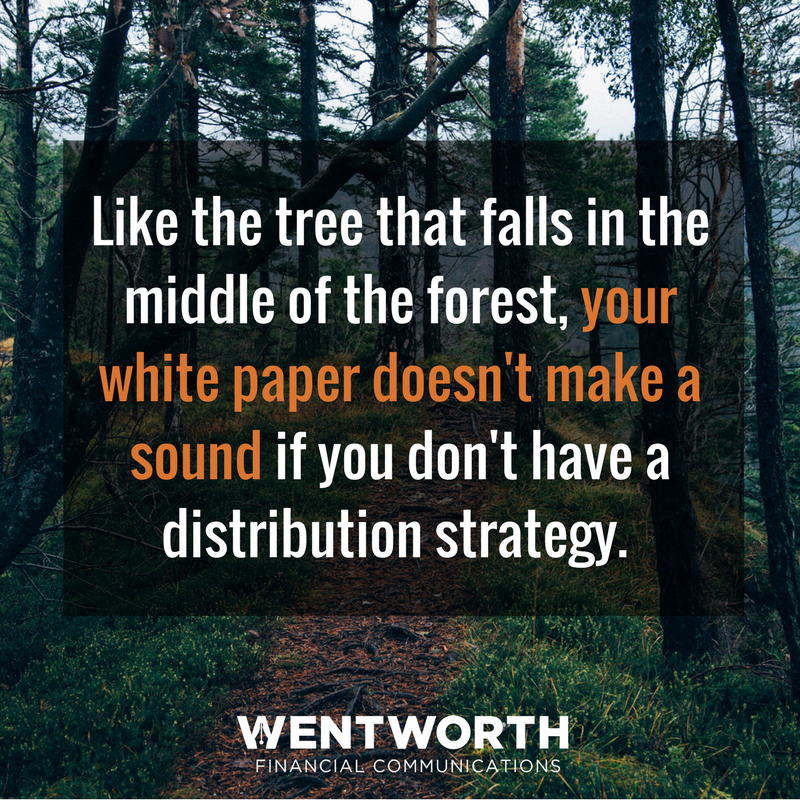 “If a tree falls in a forest and no one is around to hear it, does it make a sound?” While we wait for philosophers to answer that question, I think it’s time to introduce a new mental conundrum: “If a white paper gets posted only to the Resources page of a company’s website, does it count as thought leadership?”
“If a tree falls in a forest and no one is around to hear it, does it make a sound?” While we wait for philosophers to answer that question, I think it’s time to introduce a new mental conundrum: “If a white paper gets posted only to the Resources page of a company’s website, does it count as thought leadership?”
To answer this question, it’s helpful to switch our mindsets from philosophy to math. The value of a white paper in building a company’s brand and establishing the author’s credentials as a thought leader is a function of two factors: 1) the quality and depth of the insights in the paper and 2) the number of relevant people who see the paper. You don’t have to have a PhD in mathematics from MIT to know that if either one of the factors in a multiplication equation is close to zero, than the product is going to be rather small.
You could write The Greatest White Paper In the History of the Financial Services Industry, but if it doesn’t get distributed to the right people, all of the effort you put into it is for naught. That is why no white paper project is complete until you have developed—and executed—a strategy for distributing the paper.
Strategies for Distributing Financial White Papers
I don’t mean to imply that posting a white paper to your website’s “Resources” or “Insights” page is a bad idea. In fact, you’d be remiss not to put your white paper there. But if that is the beginning and end of your white paper distribution strategy, then you are leaving a lot of money on the table.
When it comes to getting the white paper in front of the right audience, you want to make sure you are taking advantage of the many different channels at your disposal. We recommend that financial services firms use some mix of the following owned, earned, and paid channels in their white paper distribution strategies:
Owned Channels: You’ve Already Built It, So Fully Leverage It
- Website: In addition to posting the white paper as a PDF to the “Resources” or “Insights” page, you may also want to link to the white paper on more product-, asset class-, or vertical-specific pages on your website, as well as the authors’ bio pages. For example, if Pam, a portfolio manager at your firm, writes a white paper on emerging market equity valuations, you could have the white paper in the following three places: 1) resources/insights page, 2) emerging markets page, and 3) Pam’s bio. Also, white papers can be powerful tools for increasing your search-engine rankings on a particular topic. But know that Google and other search engines can’t read PDFs the way they can read HTML copy. So you may want to consider creating an HTML version of the white paper, in addition to having the fully designed PDF available for download.
- Email: Your email database is one of your most valuable marketing assets, and you should include your thought leadership as part of your email marketing efforts. The more that you can segment your distribution and only send white papers that are highly relevant to a specific segment of your audience, the better. For example, if you’re an asset management firm and you market to both the wholesale and retail channels, sending a white paper about personal finance tips for the mass affluent might hurt your credibility with financial advisors at wirehouses. Conversely, sending a white paper about the mechanics of different alternative investment vehicles might be too technically dense for your retail audience.
- Social media: LinkedIn and Twitter can be powerful tools for generating more visibility for your white paper. For LinkedIn, in addition to posting “updates” that link directly to the white paper on your website, you may want to consider posting snippets from the white paper as 800- to 1,200-word posts using LinkedIn’s native blogging tool. (Note: some firm’s compliance departments don’t allow employees to use this tool.) Also, you can look for any “groups” that might be interested in your white paper topic and post a link to the white paper as a thread for that group. For example, if you’re an estate planning attorney and your publication is about estate planning for dentists, physicians, and other medical professionals who own their own practices, you could look for groups focused on practice management for those fields.
Earned Channels: You Don’t Ask, You Don’t Get
- “Guesting” on blogs and podcasts: In any industry—and financial services is certainly no exception—there are influencers who have developed large followings through their blogs and podcasts. You may want to consider tapping into these existing audiences. Just like actors go on the talk-show circuit whenever they have a new movie coming out, white paper authors should go on the blog/podcast circuit to promote their thought-leadership papers. The hosts of these blogs and podcasts are always looking for new, high-value content, so reach out to them via email and offer to be a guest contributor by sharing some insights from your white paper.
- Trade publications and other media: If your white paper is any good, it includes some valuable new insights and perspectives about the financial services industry. Do you know who loves getting access to valuable new insights and perspectives? Reporters at trade publications, that’s who. Create a targeted list of the 3-to-5 most valuable publications in your industry, and reach out to the relevant reporter at each publication, offering them an “embargoed” look at the white paper before it is released to the public. Or, you could pick one publication and offer them an “exclusive” where they get to write about the white paper before anyone else.
- Conferences: Almost every portfolio manager, investment banker, estate planning attorney, and financial advisor wants to land speaking engagements as a way to generate more leads and build their brands. Landing these coveted spots can be challenging, but having a white paper can help. Including the white paper as part of your nomination can bolster your bona fides as a true thought leader and give the conference organizers an idea of the depth of expertise you can provide in your session. And if your white paper is particularly compelling, the conference may want you to craft an entire presentation about that exact topic.
Paid Channels: You’ve Got to Pay-To-Play
- Webinars: Many trade publications and industry associations have figured out that a good way to leverage their audience base and generate additional revenue is by hosting sponsored webinars. For a few thousand dollars (usually), you can pay to host a webinar where you talk through the findings from your white paper. While some firms balk at the cost of a webinar, you need to consider that these can be high-impact events. The cost generally includes the publication/association advertising the webinar to their subscriber/member base, so you’re getting direct exposure to a high-value target audience.
- Sponsored ads, pay-per-click, and retargeting: If you Google a financial topic, there’s a good chance that one of the first results to show up will be a link to a white paper with the word “ad” next to it (sponsored ads). Or you might see a link to a white paper show up in the right margin (pay-per-click). Or if you visit a company’s website or social media page, you might see an ad for one of their white papers show up sometime later in your web browsing (retargeting). There are lots of ways to use advertising dollars to generate more views for your white paper. While this can be effective, you need to have a fairly sizable ad budget to get much traction, for most topics.
Making Sure Your White Paper Makes a Sound
The point of writing a white paper is to establish yourself as a thought leader in the financial services industry and build your brand. No matter how well-written the white paper is, its ultimate value is directly related to your ability to get the white paper in front of the right audiences. Considering the amount of work that you put into writing, editing, and designing your white paper, you don’t want to come up short when it comes to your distribution strategy, and leave money on the table.
About the Author
 Scott Wentworth is the founder and head writer at Wentworth Financial Communications. Scott and the team of writers and editors at WFC help firms across the financial services industry turn their expertise into investment-grade white papers, bylined articles, newsletters, and other forms of thought leadership. To learn more, visit www.wentworthwriting.com.
Scott Wentworth is the founder and head writer at Wentworth Financial Communications. Scott and the team of writers and editors at WFC help firms across the financial services industry turn their expertise into investment-grade white papers, bylined articles, newsletters, and other forms of thought leadership. To learn more, visit www.wentworthwriting.com.
